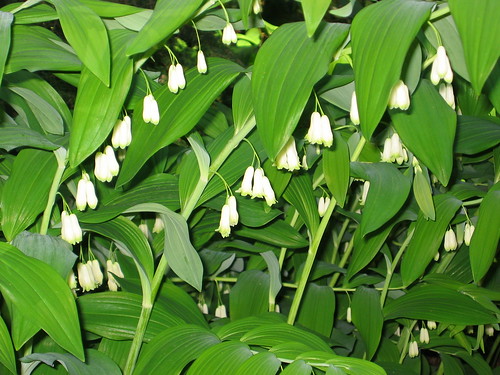Flower Arranging – Solomon’s Seal

The Complete Guide to Flower Arranging by Jane Packer
Using Solomon’s Seal for Flower Arrangements
- Solomon’s Seal is one of the Polygonatum genus.
- They spread by rhizomes in rich, moist soil in partial or full shade.
- Flowers are often followed by red or black berries and in autumn the leaves turn an eye catching yellow.
- Popular varieties of Solomon’s seal include:
Polygonatum hybridum 8″ long arching stems with alternate flowers on the top side of the stem.
Polygonatum biflorum or Greater Solomon’s Seal is larger reaching 5 feet.
Polygonatum multiflorum can have green and cream striped leaves.
Polygonatum odoratum has green tipped white scented flowers suspended below the stem.
Special Tips – Flower Arranging – Solomon’s Seal
- Solomon’s Seal has many uses in flower arranging from the massed pedestals to modern arrangements using only a limited amount of material.
- Try removing all the leaves and leaving just the flowers. This provides a very graceful line to an arrangement.
- Condition by standing in tepid water at least overnight. They then have a vase life of 10 days plus.
- Preserve stems for winter by Glycerining the cut stems
- How to Glycerine. Mix one part glycerine with two parts hot water and after cooling stand the stems in the solution for 7-10 days until they change colour right to the tips. Store flat in boxes until required
A full array of books on Flower Arranging and related subjects is available from Amazon. You will find more advice and artistic inspiration amongst this selection.
I would also recommend the Harrogate spring flower show where I am always stunned by the floral arrangement amongst the plants on display.

Credits
Great Solomon’s Seal and Sweet Woodruff by bill barber CC BY-NC 2.0
Silver bells by sonyaseattle CC BY-NC-SA 2.0
Japanese flower arrangement 1 by mharrsch CC BY-NC-SA 2.0
.

Solomon’s seal or David’s Harp is a Polygonatum with arching stems of leaves and flower bells that is in demand for a range of flower arrangements. They can be grown in moist well drained soil but are one plant that likes dry shade.
To grow a generic mix of flowers for arrangements and bouquets check out Thompson & Morgan
Other plants discussed in this series
Dahlia
Euphorbia
Pittosporum
Alstroemeria
Fatsia Japonica
Corkscrew hazel
Phormium

One thought on “Flower Arranging – Solomon’s Seal”
Comments are closed.